
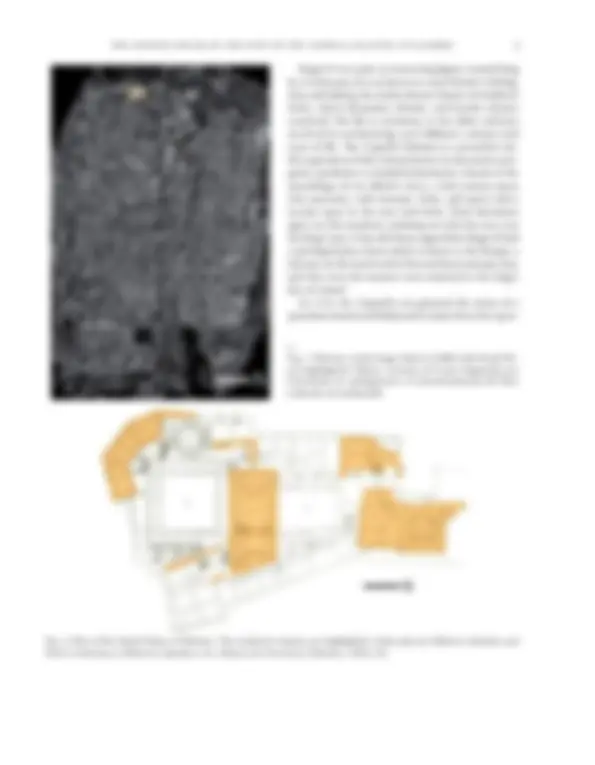
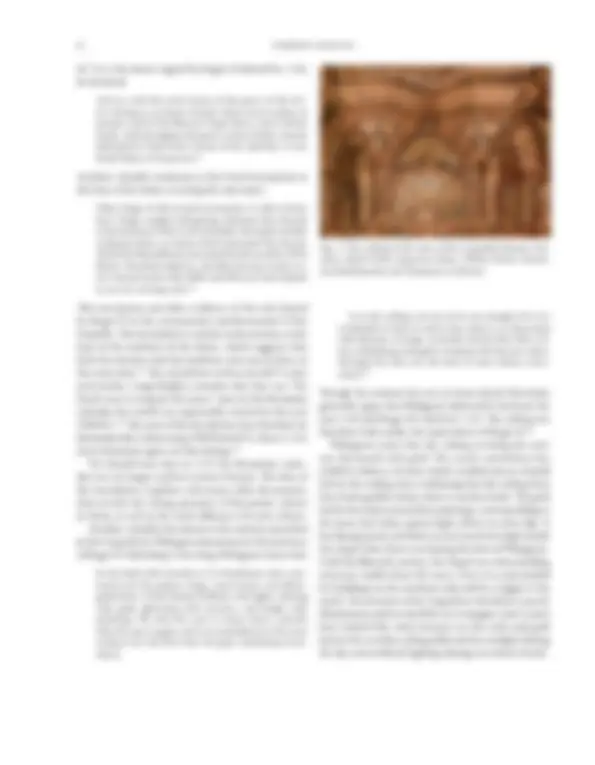
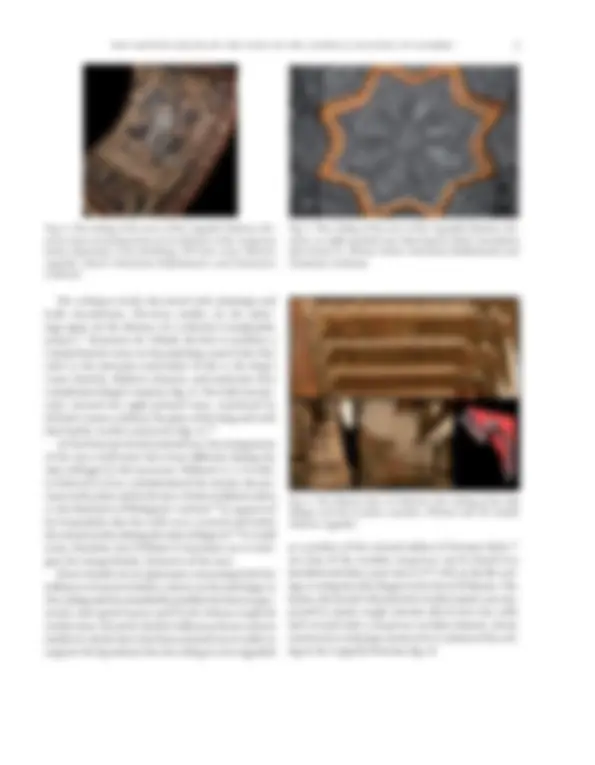


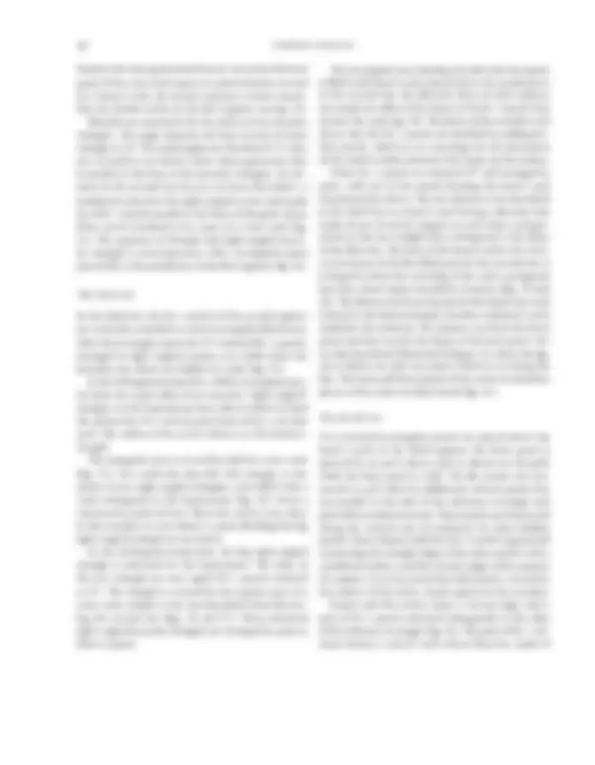
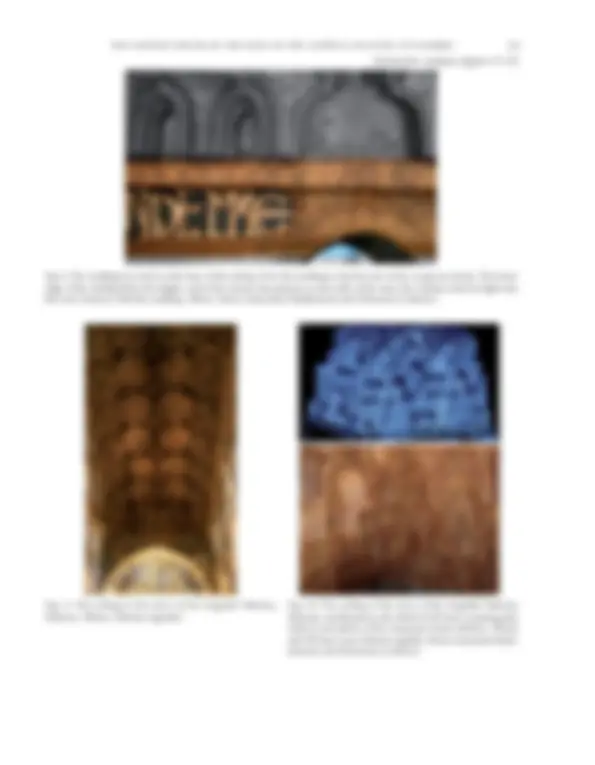
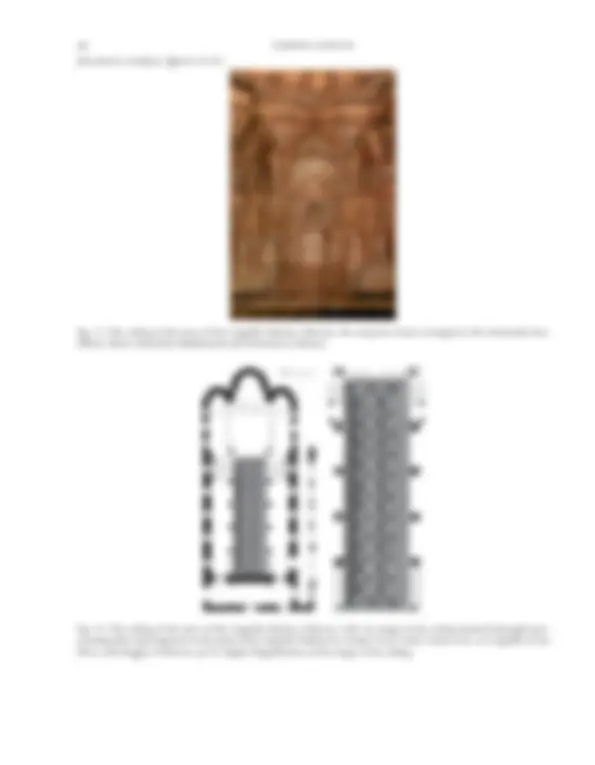
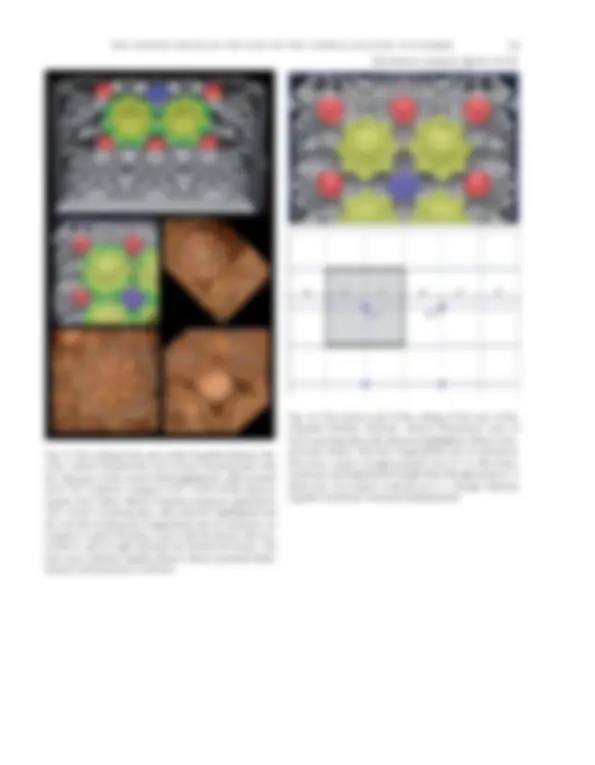
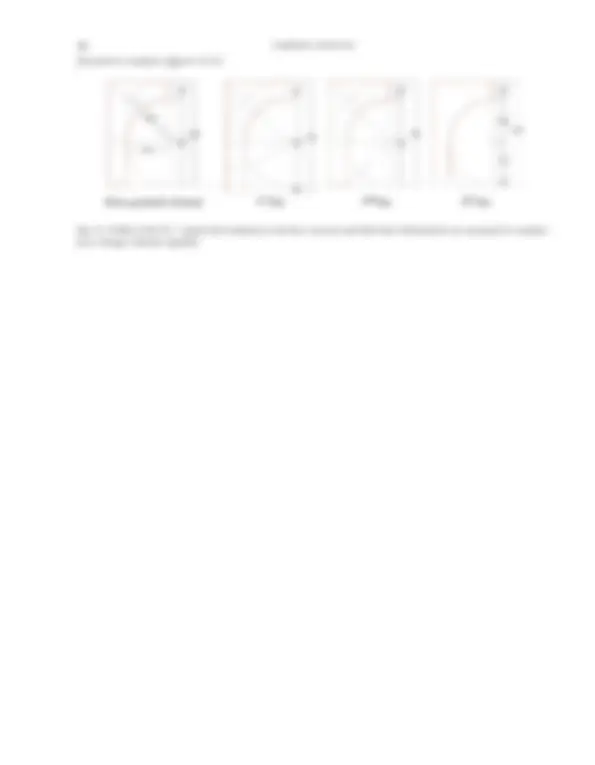
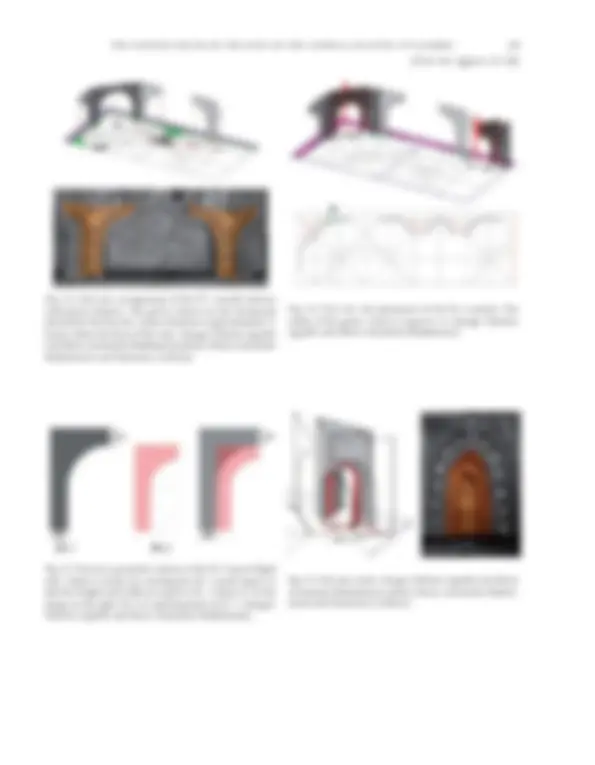
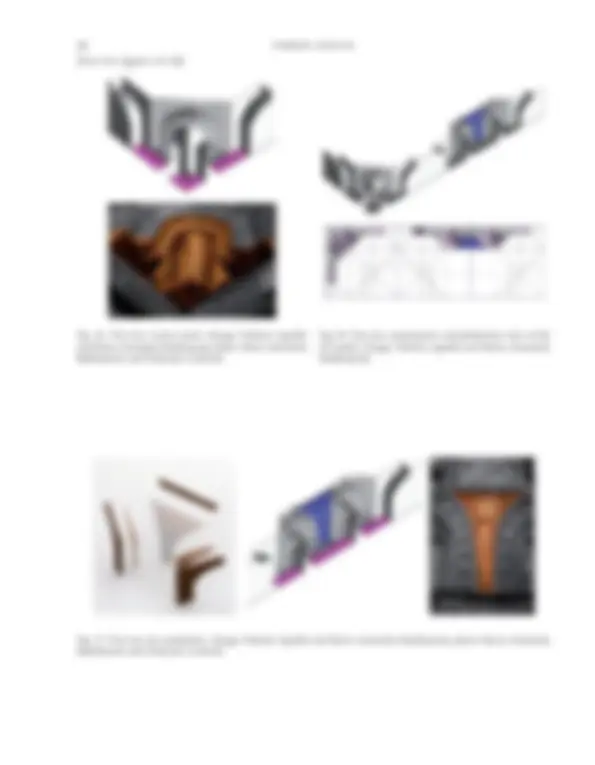
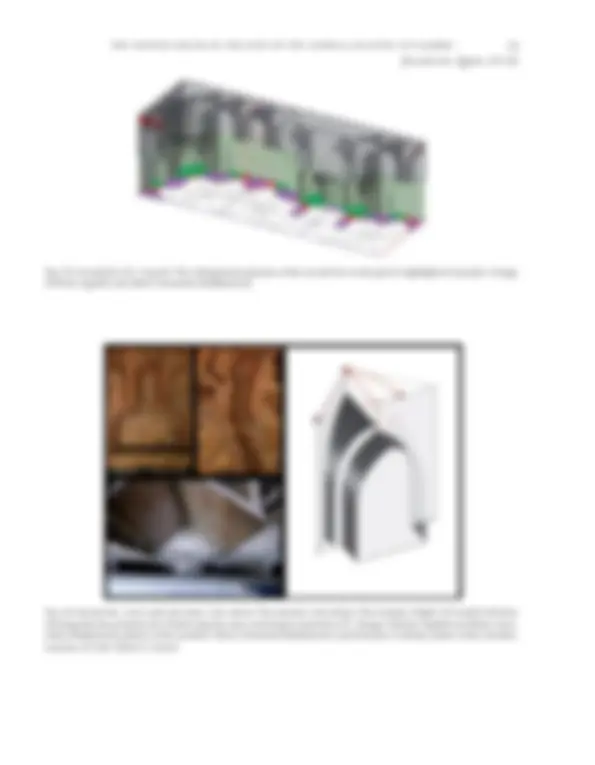
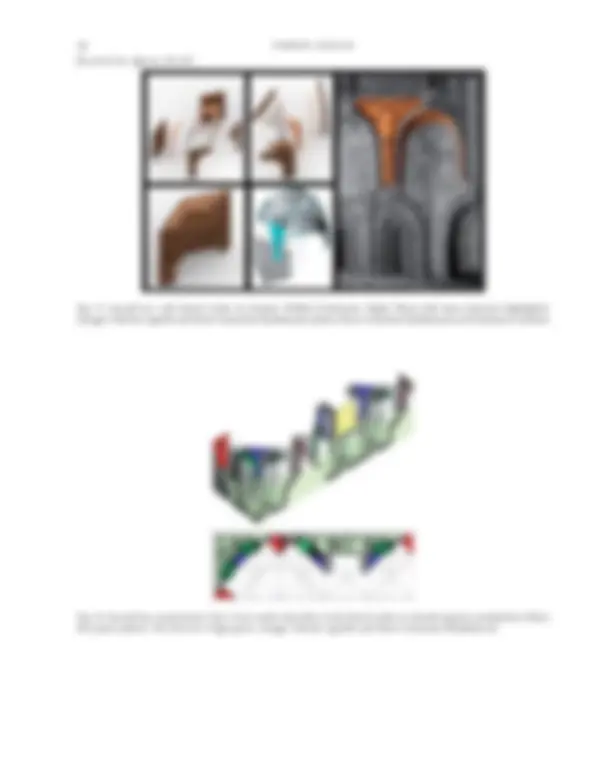
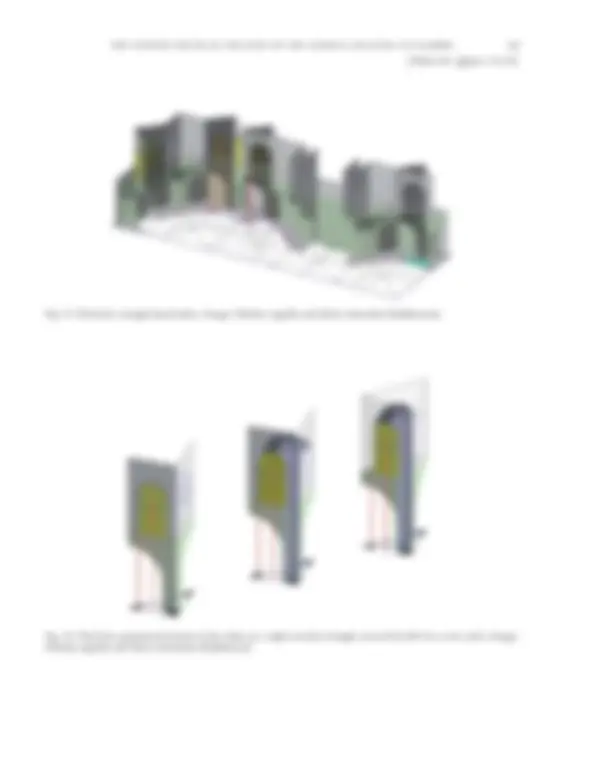
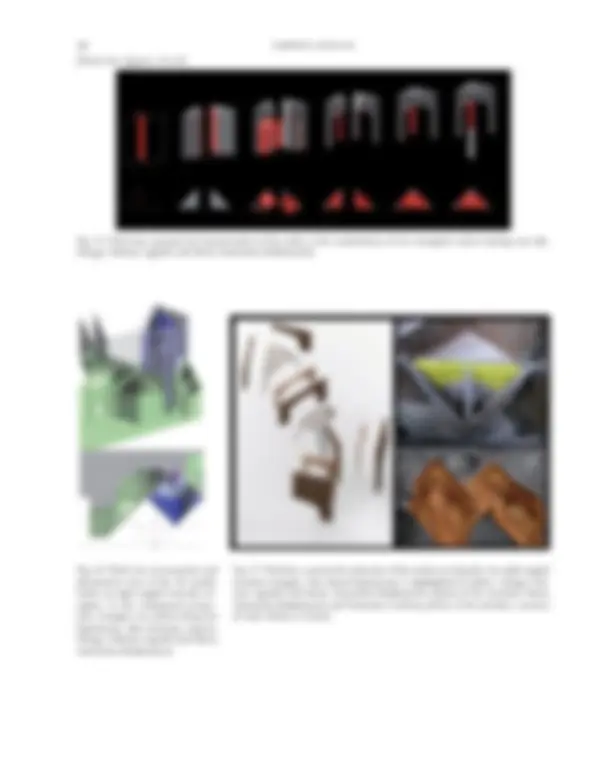
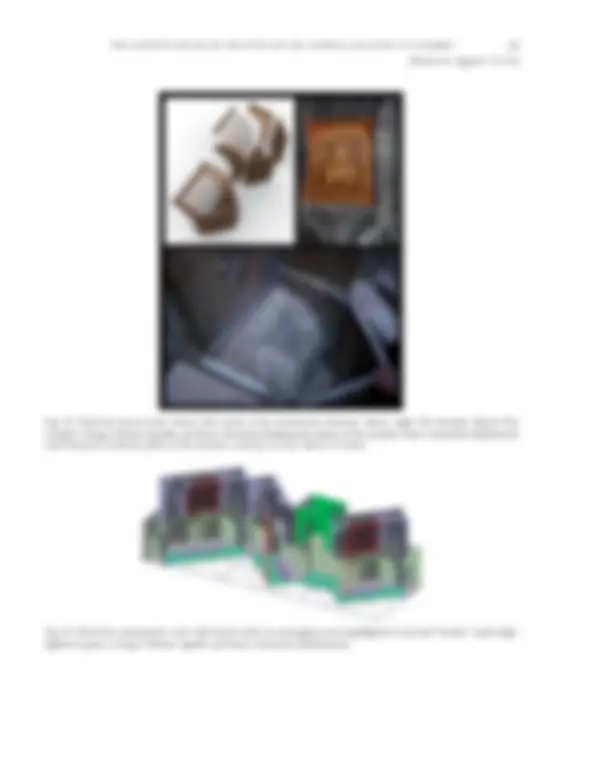
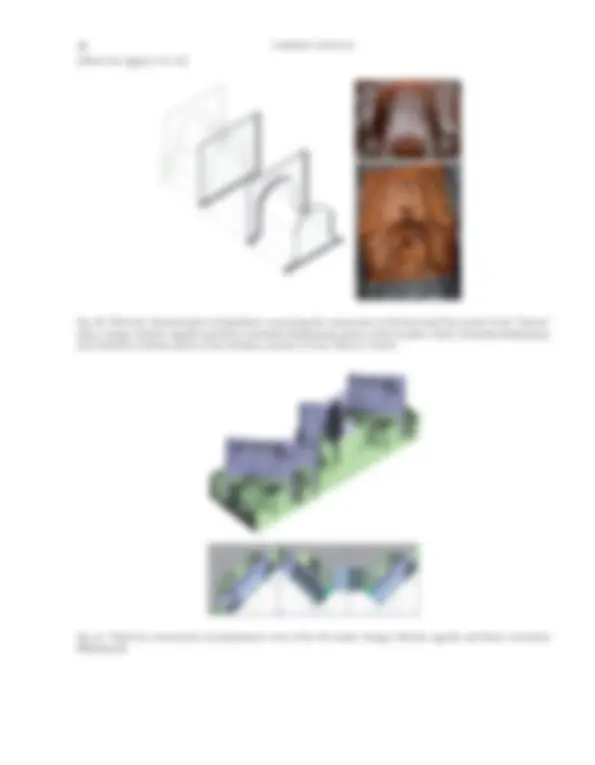
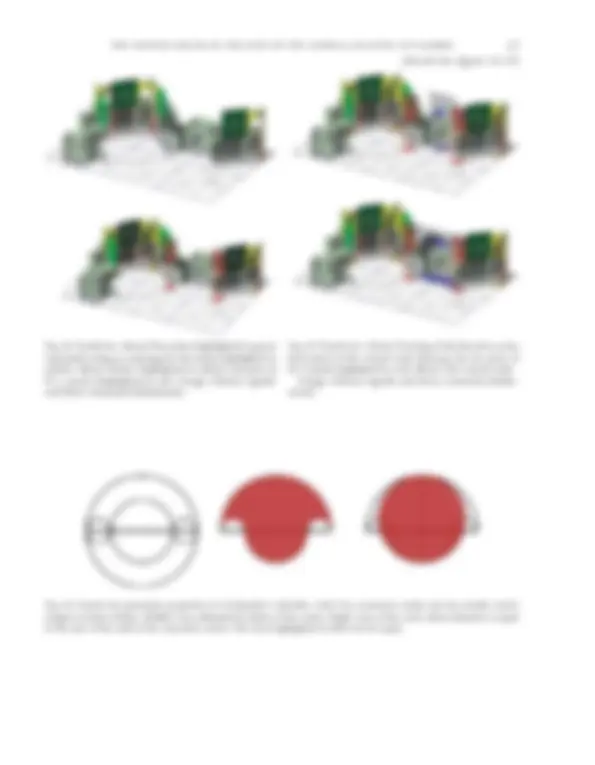
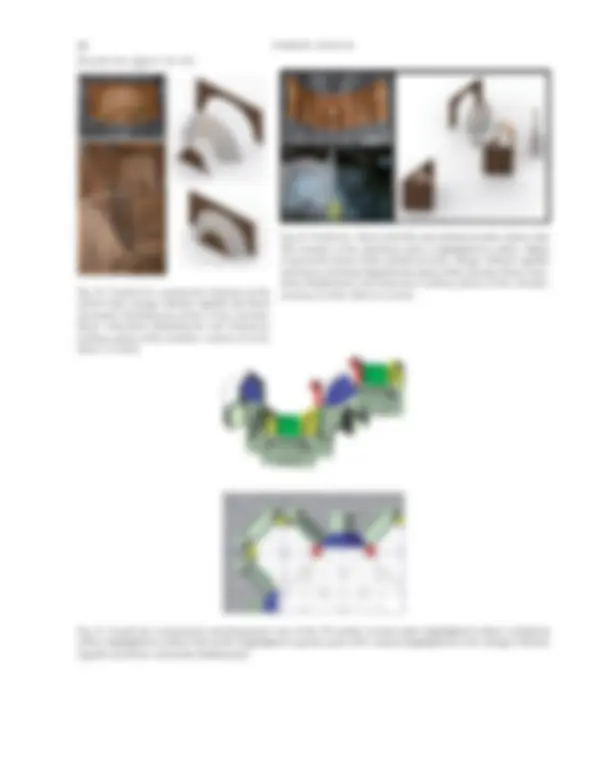
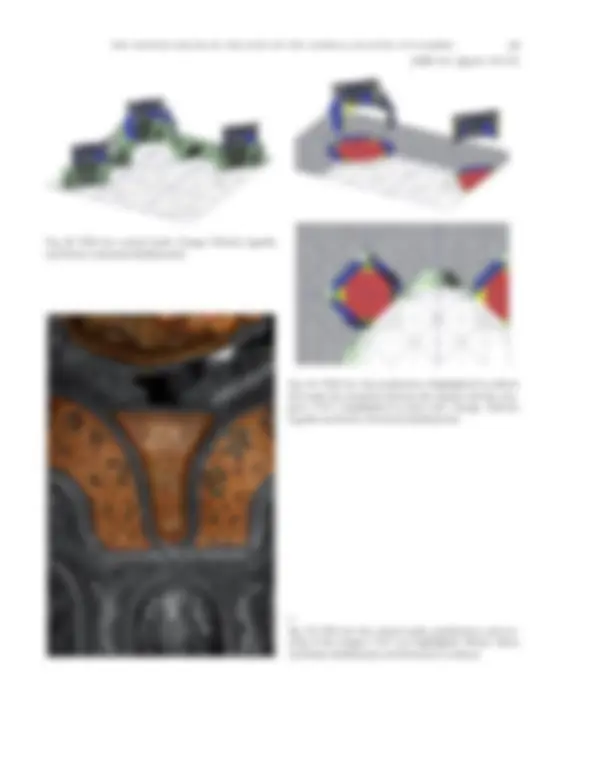
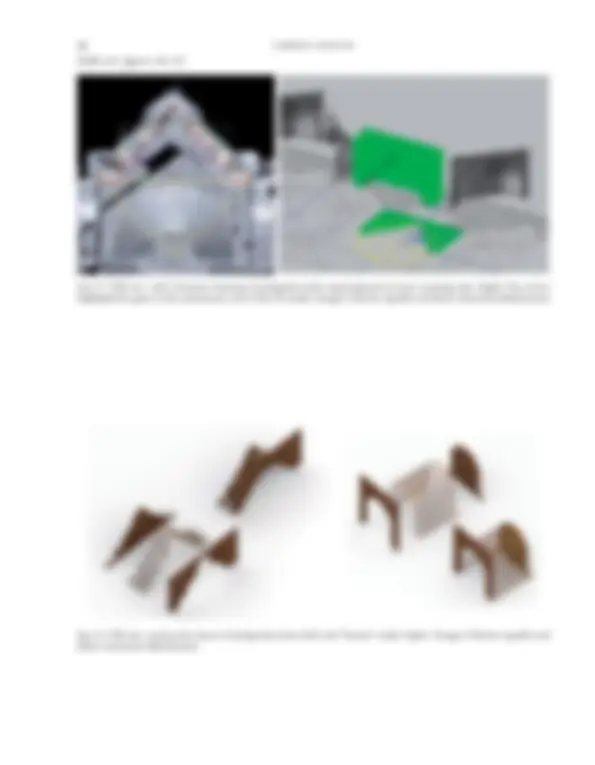
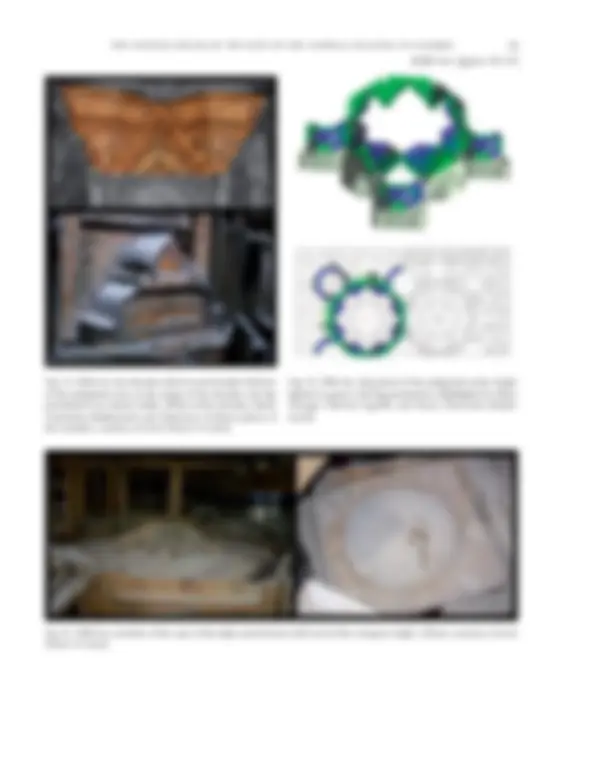
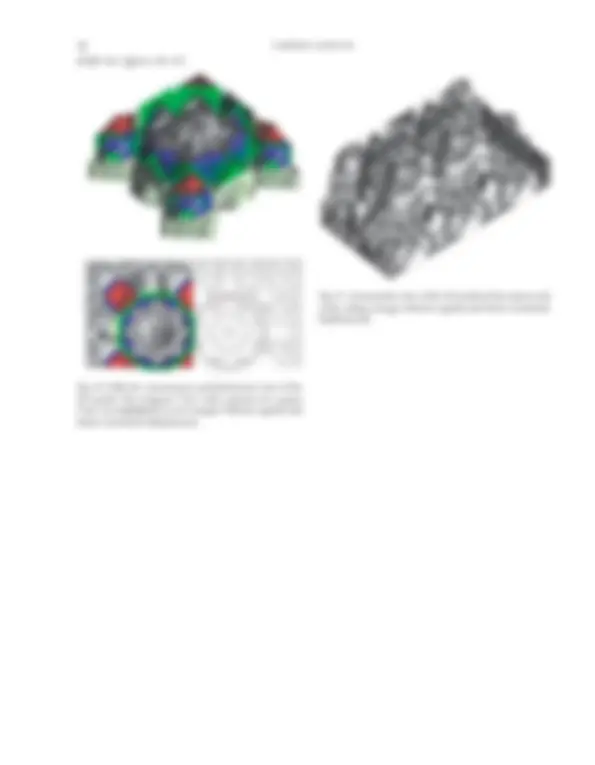
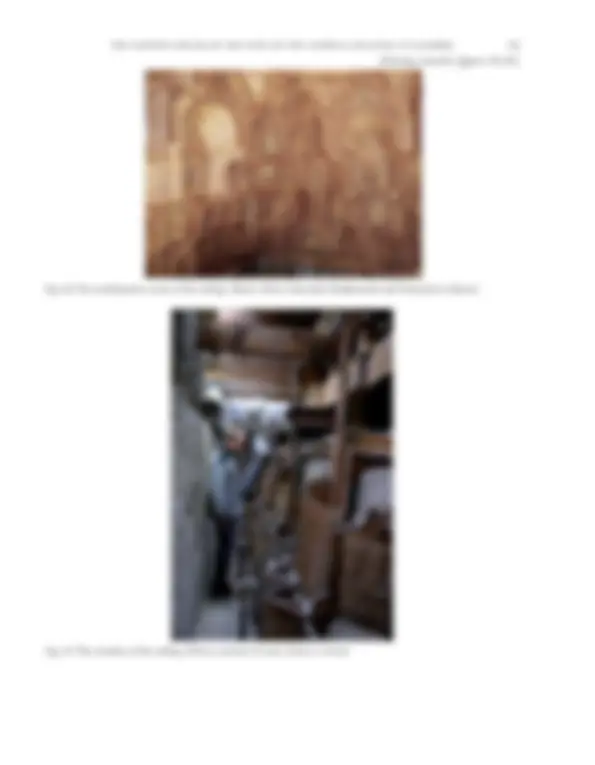
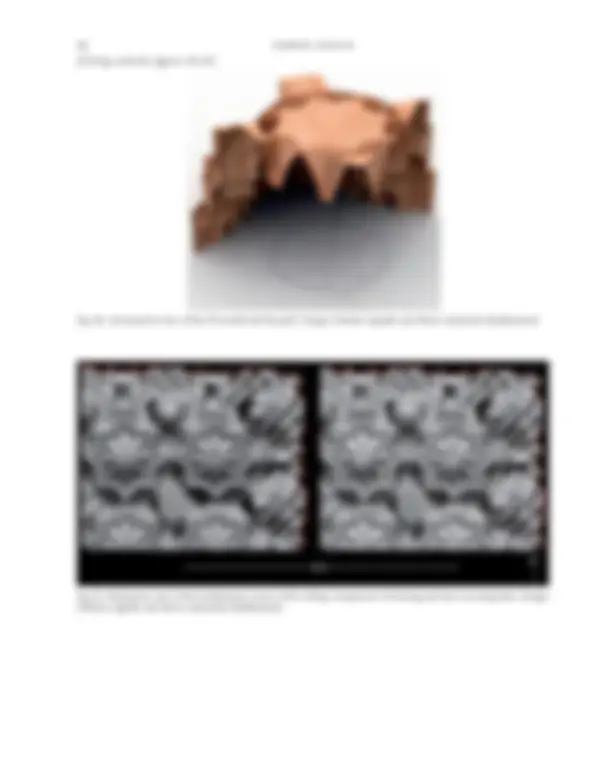





Study with the several resources on Docsity

Earn points by helping other students or get them with a premium plan


Prepare for your exams
Study with the several resources on Docsity

Earn points to download
Earn points by helping other students or get them with a premium plan
Community
Ask the community for help and clear up your study doubts
Discover the best universities in your country according to Docsity users
Free resources
Download our free guides on studying techniques, anxiety management strategies, and thesis advice from Docsity tutors
The history and restoration of the Cappella Palatina in Palermo, Sicily, focusing on its unique ceiling. The ceiling, influenced by Norman Sicily and its patron Roger II, reflects the impact of multicultural influences in Sicilian architecture. previous research and important contributions to the study of the ceiling, including the comprehensive restoration funded by Reinhold Wurth.
Typology: Summaries
1 / 37

This page cannot be seen from the preview
Don't miss anything!






























the painted ceiling of the nave of the cappella palatina in palermo (^1)
FABRIZIO AGNELLO
This inquiry investigates the geometrical and structural features of the wooden ceiling covering the nave of the Cappella Palatina in the Royal Palace (Palazzo Reale) of Palermo. 1 We do not offer here either an in-depth historical analysis or a detailed description of the rich and interesting paintings decorating the ceiling. Such issues have been widely investigated, mainly by art and architecture historians. 2 Rather, a brief discussion of the history of the Cappella is meant to draw attention to some of the previous studies on the cultural influences underlying the artistic and architectural features of this building in order to contextualize our findings on the geometric layout of the ceiling covering the nave. Today, the ceiling on the nave of the Cappella Pala- tina appears to be the sole surviving example of this type of complex, painted wooden carpentry in Islamic culture. Given the absence of other similar examples, it could be argued that the ceiling is the peculiar prod- uct of multicultural Norman Sicily, and reflects the influence of its patron, Roger II (r. 1130–54). It is dis- tinguished from other similar artifacts in Islamic art mainly by the material of which it is made and the tech- nique used to construct it. Most muqarnas vaults are made of stone or stucco, with single elements that are carved or molded. In the ceiling of the Cappella Pala- tina, however, the spatial layout of the muqarnas is pro- duced by a segmentation of the form: that is, it is divided into arch-shaped primary panels and into secondary hidden panels, which act as centerings for the place- ment of thin wooden elements that form the surface of the small vaults. No ceiling like that of the nave of the Cappella Palatina has survived in Sicily, but we will see that it must have served as the inspiration for the con- soles of a later ceiling in Palermo.
This first study of the geometrical and constructive features of the ceiling is just one contribution to the research that has been conducted regarding the ori- gin of the craftsmen and the cultural influences under- lying the ceiling and its creation. The precise drawing of a reference grid, which will be described below, and the relations between that grid and the drawing of the shape of the vertical primary elements, referred to as “EL” panels in the following discussion, demon- strate that the ceiling was meant to be not a peripheral creation, but a unique and magnificent expression of Islamic culture. The Norman kingdom put an end to two centuries of Islamic domination in Sicily, even as it maintained relations with Islamic countries in North Africa and demonstrated an appreciation for Islamic art and architecture. The establishment of the Norman kingdom did not interrupt the influence of Islamic cul- ture on art and architecture in Sicily. We see the remains of this impact in the ceiling of the Cappella Palatina, as well as in some palaces in Palermo that are still stand- ing—the Zisa, Cuba, and Scibene—all of which were commissioned by Norman kings.
Between 2005 and 2009, the Cappella Palatina under- went an accurate and comprehensive restoration, financed by a generous grant from Reinhold Wurth and directed by the Soprintendenza per i Beni Cul- turali of Palermo. The provisional structures used by the restorers allowed for new and closer views of the mosaics and other decorations, and gave researchers the chance to observe the ceiling from a privileged per-
2 fabrizio agnello
spective. 3 Some of the best previous inquiries on the Cappella presumably also used provisional structures, either to get detailed photographs, such as, for instance, the ones published in Ugo Monneret de Villard’s Le pitture musulmane al soffitto della Cappella Palatina in Palermo, or to survey the ceiling. The precise drawings done by Andrea Terzi in the late nineteenth century, which are discussed below, must have been based on measurements and observations attainable at that time only by actually touching the ceiling by hand. 4 The results of the research here reported were based on 3D laser-scanning data of the eastern end of the wooden ceiling and on a survey of the dimensions of the entire nave. Indeed, 3D laser scanning has profoundly transformed the approach to cultural heritage analy- sis and documentation. Laser scanners quickly measure the 3D coordinates of a large number of points (usually referred to as a “point cloud”) of the visible surfaces of an object; they also photograph the scanned area and link color values (RGB) to each surveyed point. With 3D laser scanning, scholars are able to examine an artifact in detail, allowing for both geometric analyses and the study of the quality and position of any colored feature. The 3D scanners are usually classified as long, medium, or close-range, depending on the distance allowable between the device and the object. The data measured in this inquiry were collected via a close-range optical tri- angulation laser scanner, 5 a highly accurate device that can detect distances of less than 1 millimeter; it is usu- ally positioned at about 1.5 meters from the object and the scan is performed in a few seconds. Several scans of the area under examination were collected; they were registered to form one point cloud, which became the basis for the geometric analysis described in this paper. There have been several studies devoted to the geo- metric analysis of the muqarnas vaults, mainly as a way to reconstruct the horizontal grid pattern of the vaults. The analysis of the elevation has often been regarded as a secondary matter, since it was assumed that the height of the tiers of the muqarnas was determined by the dimensions of the vaults and by the 1:2 ratio of the sides of the rectangle inscribing the basic ele- ment, in accordance with the description furnished by Al-Kashi in his treatise Miftāh al-hisāb (Key to Arith- metic). Laser scanning and 3D modeling software allow in-depth inspection of the three-dimensional features of
the muqarnas vaults, offering the opportunity for new studies on the relations between the grid patterns and elevations. As indicated above, laser scanners have generally been considered an effective technology for document- ing of cultural heritage; they are particularly useful with respect to the issue of conservation. In this study we attempt to demonstrate that laser-scanning data can be employed to reconstruct the “reference drawing” of the ceiling of the Cappella Palatina and that rela- tions between the reference grid and the elevation of the muqarnas vaults can be discerned by means of 3D metric data. We argue that this relation should not be regarded as a distinguishing feature of the ceiling of the Cappella Palatina, but rather as a common prac- tice of craftsmen in Islamic and in premodern Euro- pean art and architecture: “in the Topkapı and Tashkent scrolls abstract designs generated from modular geo- metric grids unencumbered by specific measurements were meant to be proportionally adapted to buildings and local materials at the construction time....Elevations were deduced by means of geometric procedures also common to Gothic building practice in which learn- ing the method of projecting three-dimensional forms from two-dimensional templates played a central role.”^6
The Cappella Palatina is located in the Royal Palace of Palermo, at the western edge of the historical town (fig. 1). The history of the foundation and construction of the Royal Palace, though widely investigated, is still uncer- tain. What seems definite is that the site was selected as the residence of the Normans when Robert “il Guis- cardo” (d. 1085) and his brother, Count Roger (d. 1101), conquered Palermo in 1072. They began building the palace on the ruins of a previously fortified site, as a counterpart to the fortified Muslim residence located by the sea at the eastern edge of the old town. Count Roger’s son, Roger II, took advantage of the succession dispute that broke out following the death of Pope Hon- orius II, and was proclaimed king of Sicily by Anacletus II (d. 1138) in December 1130. 7 We know that Roger II was the patron of the Cappella Palatina (fig. 2).
4 fabrizio agnello
tle. 9 In a document signed by Roger II himself in 1140, he declared:
And so, with the seven forms of the grace of the Sav- ior stirring us, in honor of God, whose mercy makes us prosper, and of the Blessed Virgin Mary, and of all the Saints, with the highest devotion, we have built a church dedicated to Saint Peter, Prince of the Apostles, in our Royal Palace in Panormo. 10
Another valuable testimony is the Greek inscription at the base of the dome covering the sanctuary:
Other kings of old erected sanctuaries to other Saints; but I, Roger, mighty ruling king, [dedicate this church] to the foremost of the Lord’s disciples, the leader and the archpriest Peter, to whom Christ entrusted His church, which He Himself had consecrated by the sacrifice of His blood...The third indiction...the fifty-first year in the cor- rect measurement after 6000 and 600 years had elapsed in an ever moving cycle. 11
This inscription provides evidence of the role played by Roger II in the construction and decoration of the Cappella. The inscription is written in the mosaics at the base of the tambour of the dome, which suggests that both the mosaics and the tambour were put in place at the same time. 12 The calculation of the year 6651 is also noteworthy: Luigi Boglino remarks that this was “the Greek way to compute the years,” since in the Byzantine calendar the world was supposedly created in the year 5508 B.C. 13 The year of the inscription may therefore be determined by subtracting 5508 from 6651, that is 1143; most historians agree on this dating. 14 We should note that in 1143 the Byzantine calen- dar was no longer used in western Europe. The date of the inscription, together with many other documents, thus reveals the strong presence of Byzantine culture in Sicily, as well as the weak influence of Latin culture. Another valuable document is the sermon preached in the Cappella by Philagatos Kerameos in the presence of Roger II. Referring to the king, Philagatos notes that
he has built [this church] as if a foundation and a pro- tection for his palaces; large, most lovely, and distin- guished by a fresh beauty; brilliant with lights, shining with gold, glittering with mosaics, and bright with paintings. He who has seen it many times, marvels when he sees it again, and is as astonished as if he were seeing it for the first time, his gaze wandering every- where.
As to the ceiling, one can never see enough of it; it is wonderful to look at and to hear about. It is decorated with delicate carvings, variously formed like little cof- fers; all flashing with gold, it imitates the heavens when, through the clear air, the host of stars shines every- where. 15 Though the sermon has not yet been dated, historians generally agree that Philigatos delivered it between the year 1140 and Roger II’s death in 1154. The ceiling was therefore built under the supervision of Roger II. 16 Philagatos states that the ceiling covering the nave was decorated with gold. The recent restoration has yielded evidence of some small, residual pieces of gold leaf on the ceiling, thus confirming that the ceiling must have had a golden sheen when it was first built. The gold leaf in the strips around the paintings, corresponding to the areas that today appear light yellow in color (fig. 3) has disappeared, and there is now much less light inside the chapel than there was during the time of Philagatos. Until the fifteenth century, the chapel was a freestanding structure visible from the town. Now it is surrounded by buildings on the northern side and by a loggia to the south. The interior of the Cappella is therefore scarcely illuminated, and it is hard for us to imagine what it must have looked like when mosaics on the walls and gold leaf on the wooden ceiling reflected the sunlight during the day and artificial lighting during nocturnal rituals.
Fig. 3. The ceiling of the nave of the Cappella Palatina, Pal- ermo: detail of the muqarnas frame. (Photo: Maria Antoni- etta Badalamenti and Domenico Carbone)
the painted ceiling of the nave of the cappella palatina in palermo (^5)
as a product of the cultural milieu of Norman Sicily. 21 An echo of the wooden muqarnas can be found two hundred and thirty years later (1377–80), in the flat ceil- ing covering the Sala Magna in the Steri of Palermo. The beams, decorated with painted, wooden panels, are sup- ported by small, rough consoles driven into the walls and covered with a muqarnas wooden element, whose constructive technique seems to be a citation of the ceil- ing in the Cappella Palatina (fig. 6).
The ceiling is richly decorated with paintings and kufic inscriptions. Previous studies on the paint- ings agree on the absence of a coherent iconographic project. 17 Monneret de Villard, the first to produce a comprehensive essay on the paintings, asserts that they refer to the pleasures and habits of life at the king’s court; hunters, drinkers, dancers, and musicians thus complement Roger’s majesty (fig. 4). The kufic inscrip- tions around the eight-pointed stars, translated by Michele Amari, celebrate the glory of the king and wish him health, wealth, and power (fig. 5). 18 As has been previously pointed out, the arrangement of the nave itself must have been different during the time of Roger II. His successor, William I (r. 1154–66), is believed to have commissioned the mosaic decora- tions in the aisles and in the nave. Maria Andaloro refers to the third part of Philagatos’s sermon 19 in support of her hypothesis that the walls were covered with richly decorated textiles during the time of Roger II.^20 It would seem, therefore, that William I’s intention was to miti- gate the strong Islamic character of the nave. Most scholars are in agreement concerning both the influence of eastern Islamic culture on the paintings on the ceiling and the remarkable parallels between its geo- metric and spatial layout and North African maghribi architecture. Recently, further influences from western medieval culture have also been pointed out in order to support the hypothesis that the ceiling is to be regarded
Fig. 4. The ceiling of the nave of the Cappella Palatina, Pal- ermo: laser-scanning survey of an element in the muqarnas frame depicting a man drinking. (3D laser scan: Fabrizio Agnello, Maria Antonietta Badalamenti, and Domenico Carbone)
Fig. 5. The ceiling of the nave of the Cappella Palatina, Pal- ermo: an eight-pointed star showing the Kufic inscription that frames it. (Photo: Maria Antonietta Badalamenti and Domenico Carbone)
Fig. 6. The Palazzo Steri in Palermo: the ceiling of the Sala Magna and the wooden consoles. (Photos and 3D model: Fabrizio Agnello)
the painted ceiling of the nave of the cappella palatina in palermo (^7)
up an adequate reference system, Grube offers a com- prehensive description of the subjects of the paintings, concluding with some interesting stylistic remarks on them, strongly supported by a comparison with coeval minor arts (ivories, pottery, woodworks, etc.) in medi- eval Sicily. The essays are followed by a rich collection of images: detailed photos of the ceiling, historic pictures of the Cappella, and an accurate “assembly of iconographi- cal parallels to the Cappella Palatina paintings.” 27 The Grube and Johns’s book closes with a comprehensive bibliography of more than two hundred pages.
(Figures 8-61 are grouped together at the end of the article.)
The present analysis, based on data gathered by 3D laser- scanning and restricted to the eastern area of the ceiling, investigates the geometry of the orthogonal projection of the ceiling, as well as, through hypothesis, the geo- metric relationships between the horizontal projection and the spatial arrangement of the muqarnas frame. 28 The ceiling is set upon a horizontal wooden cavetto molding whose lower end crosses the upper part of the windows that allow light into the nave (fig. 8). Upon first inspection of the entire ceiling, we detect a longitudinal and transverse symmetry; an axis of symmetry oriented at a 45° angle, which is repeated in each of the corners, appears as well. The ceiling is composed of a central hor-
Fig. 7. Cappella Palatina in Palermo: drawings of the ceiling by Andrea Terzi. (After Michele Amari et al., La Cappella di San Pietro nella Reggia di Palermo, dipinta e cromo litografata da Andrea Terzi [Palermo, 1882: repr. Palermo, 1987], pl. XXXVI)
8 fabrizio agnello
izontal field with a star-and-crosses pattern and hang- ing bosses; a muqarnas frame made of small, vaulted niches arranged in five horizontal tiers makes the tran- sition between the central field and the walls of the nave (figs. 9–11). Our geometric analysis is supported by a study of the extrados of the ceiling, which reveals, at least for the higher tiers of the muqarnas frame (i.e., the third, fourth, and fifth tiers), the position and form of the wooden elements of which the ceiling is made. The main features of the field of the ceiling are twenty eight-pointed stars, here named “St,” arranged in two longitudinal lines (fig. 12). These stars are the result of overlaying two squares rotated at 45° angles to each other, a familiar scheme in Islamic art and architecture. Eight-pointed stars are inscribed in octagons and rhom- boidal bosses allow for the transition between them. Smaller, octagonal eight-pointed stars, here named “Oc,” are placed between the stars and the muqarnas frame; the longitudinal strip between the “St” stars is covered by squares here referred to as “Sq” (fig. 13). The geometrical analysis was conducted with refer- ence to a regular rectangle, here called the “reference rectangle,” corresponding to the horizontal section of the ceiling just above the cavetto molding. We are well aware that the horizontal section of the ceiling is not a regular rectangle, but we assume all elements con- sidered in the geometrical analysis to be pure forms, thus ignoring the imperfections caused by the defor- mations that the structure has suffered in the last nine hundred years. The same method of simplification has been adopted in the analysis of the basic elements of the ceiling, almost all of which are deformed or have slightly shifted from their original position. The reference rect- angle was divided in two by a longitudinal medial axis and the central points of “St,” referred to as C-1, were thus detected. Through points C-1 transverse and longi- tudinal straight lines were drawn. The distance between the longitudinal axis and the longitudinal lines through C-1 is named d; d+d is the side of a square centered on C-1. The distance between the square and the sides of the reference rectangle is d; that is to say, the trans- verse width of the ceiling is divided into six d-length units (fig. 14). Assuming d is the basic module of the grid and con- sidering the ceiling as a whole, we discern a central grid
and an external frame; the central field consists of 10 pairs of d+d squares, (with a 1:5 ratio); since each d+d square is made of four d-length squares, the central grid can also be regarded as if consisting of 4 per 20 d-length squares (ratio 1:5); the external frame is d wide (fig. 15). The orthogonal projection of the 3D-surveyed data leads us to assume that the vertices of the d+d squares are the center points of both the twenty four “Oc” small octagons bordering the central field and the nine “Sq” squares along the longitudinal axis of the ceiling. The center points of the “Oc”s are named C-2 and those of the “Sq”s are named C-3 (fig. 16). Dividing each segment d into three parts, a second- ary grid, made up of 36 cells per d+d square, is set up. We now draw circles circumscribing “St” and “Oc” (or “Sq”). These circles, respectively centered on C-1 and C-2 (or C-3), are tangent to each other. The tangency points are vertices of the secondary grid. The radius of the circle centered on C-2 is equal to the diagonal of the square unit in the secondary grid, while the radius of the circle centered on C-1 is equal to the length of the diagonals of two squares in the secondary grid (fig. 17). Drawing two identical squares circumscribing the circle centered on C-2, rotated at 45° to each other, we direct our attention to the small right-angled isosce- les triangles 29 that result when we subtract the square whose sides are parallel to the reference rectangle from the one that is oriented at 45°. Each triangle and its symmetrical counterpart play an important role in the following steps of our analysis. We next draw longitudi- nal and transverse straight lines connecting the hypot- enuses of the symmetrical triangles. The area between such lines and the external edge of the reference rect- angle is equal in length to the thickness of the panels in the first register (fig. 18). The end points of the hypotenuses of the green tri- angles are the center points of concentric circles. The radius of the blue circle is half the length of the hypot- enuse and the radius of the red circle is equal in length to the side of the triangle. The segment that is the dif- ference between the radius of the red circle and that of the blue circle is named m (fig. 19). The blue and red circles underlie the shape and size of a wooden vertical panel, here named EL-1. If we name the radius of the blue circle r, the width of the panel is
10 fabrizio agnello
based on the same geometrical layout. An arch in the back panel of the cross vault opens to a pointed niche covered by a barrel vault; the spatial sequence closely resem- bles the double niches in the first register (see fig. 22). Rhombs are assumed to be the union of two isosceles triangles. The angle opposite the base of each of these triangles is 45°. The equal angles are therefore 67.5°; they are covered by two barrel vaults whose generative line is parallel to the base of the isosceles triangles. An ele- ment in the second tier has not yet been described—a pendentive placed at the right-angled corner and made up of EL-1 panels parallel to the lines of the grid, whose form can be assumed to be a part of a cross vault (fig. 31). The sequence of rhombs and right-angled isosce- les triangles is interrupted by a flat, rectangular panel placed above the pendentive in the first register (fig. 32).
The third tier
In the third tier, the EL-1 panels of the second register are vertically extended to create rectangular filled areas. Only the rectangles upon the 45°-oriented EL-1 panels, arranged in right-angled couples, are visible from the intrados; the others are hidden by vaults (fig. 33). In the orthogonal projection, visible rectangular pan- els form the equal sides of an isosceles “right-angled” triangle, on the hypotenuse base side of which we find the projection of a vertical panel pierced by a circular arch. The radius of the arch is drawn on the horizon- tal grid. The triangular area is covered by half of a cross vault (fig. 34). We could also describe this triangle as the union of two right-angled triangles, each filled with a vault orthogonal to the hypotenuse (fig. 35). From a constructive point of view, this is the correct way, since in the extrados we can observe a panel dividing the big right-angled triangle in two halves. In the orthogonal projection, the big right-angled triangle is mirrored on the hypotenuse. The sides of the new triangle are once again EL-1 panels oriented at 45°. The triangle is covered by the quarter part of a cross vault, similar to the one described when discuss- ing the second tier (figs. 36 and 37). These mirrored right-angled isosceles triangles are arranged in pairs to form a square.
The rectangular area sharing one side with the square is filled with barrel vaults placed above the pendentives in the second tier; the directrix lines of such surfaces are simply an offset of the shape of the EL-1 panels that enclose the vault (fig. 38). The photo of the extrados well shows that the EL-1 panels are doubled by adding fur- ther panels, which act as centerings for the placement of the small wooden elements that make up the surface. Other EL-1 panels are oriented 45° and arranged in pairs, with one of the panels framing the barrel vault mentioned just above. The last element to be described in the third tier is a barrel vault having a directrix line made of arcs of circles tangent to each other, and gen- eratrices that are straight lines orthogonal to the plane of the directrix. The back of the barrel vault is the verti- cal extension of the flat filled panel in the second tier; it is shaped to form the centering of the vault, a polygonal base line whose shape resembles a bonnet (figs. 39 and 40). The distance between the panels that frame the vault is fixed on the horizontal grid. Another craftsmen’s trick underlies this element: the element cut from the front panel matches exactly the shape of the back panel. We see this hypothesis illustrated in figure 33, where the fig- ure is drawn on only one panel, which is cut along the line. The back and front panels of the vault are therefore pieces of the same wooden board (fig. 41).
The fourth tier Two attached rectangular panels are placed above the barrel vaults in the third register; the front panel is pierced by an arch whose circle is drawn on the grid, while the back panel is solid. The flat arches are con- nected to each other by additional vertical panels that are parallel to the side of the reference rectangle and pierced by an identical arch. These panels are intersected along the vertical axis of symmetry by other hidden panels, whose shape is half the arch. A niche is generated connecting the straight edges of the three panels with a cylindrical surface, and the circular edges with a quarter of a sphere. It is to be noted that half-panels, covered by the surface of the niche, clearly appear in the extrados. Panels with flat arches share a vertical edge with a pair of EL-1 panels oriented orthogonally to the sides of the reference rectangle (fig. 42). The pairs of EL-1 ele- ments frame a conical vault whose directrix, made of
the painted ceiling of the nave of the cappella palatina in palermo (^11)
arcs of circles tangent to each other, is similar to the one in the “bonnet” arch mentioned above (fig. 43). We should note that the shape of this polycentric arch recalls a particular geometric figure known in math- ematics as “Archimedes’s saltcellar.” The area of this shape equals the area of the circle whose diameter is the axis of symmetry of the saltcellar (figs. 44–47).
The fifth tier
The panels with flat arches in the fourth tier are verti- cally extended to form the back panel of a conical vault identical in shape to the one mentioned above (fig. 48). The conical vaults of the fifth tier form in orthogo- nal projection two sides of a square (three at the cor- ners of the ceiling). At the corners of the square, small pendentives are inserted to make the transition to the octagon named “Oc” (figs. 49 and 50). The front panels of the conical vaults in the fourth tier are vertically extended to the fifth; parallel panels are placed in the front and pierced with a polygonal arch. 30 We refer to the shape of this arch in order to demon- strate once again that craftsmen did draw all types of shapes on the horizontal grid. The geometrical anal- ysis of this arch reveals that its shape is based on the main leitmotif of the horizontal grid, that is, a pair of squares rotated 45° to one another (fig. 51). Observing the extrados of the ceiling, we see that the front and back faces of the arch are parts of the same panel cut along the polygonal line, just as was seen in the surface of fig- ure 33 (fig 52). The gap between the front and back panels of the polygonal arch is covered by a surface made of thin wooden elements (fig. 53). Other, similar panels are arranged in pairs and oriented at 45° angles. All the polygonal arches are joined to form an octag- onal area covered by the eight-pointed stars referred to as “St” at the beginning of our analysis. The transi- tion from the regular octagon to the star-shaped figure occurs through the big pendentives clearly visible from the nave (see fig. 47). The shape of the pendentives is simply a copy of the polygonal arch mentioned above. The surface is made of planar triangular elements set at 45° angles with respect to the panels bordering the octagon and intersecting each other on the diagonals of the octagon (fig. 54). The octagon is then covered by
the eight-pointed star. The octagons and eight-pointed stars are, in the constructive point of view, autonomous elements acting just like caps (fig. 55). In the orthogonal projection, the pairs of panels ori- ented at 45° play different roles, depending on their position inside the ceiling. The ones placed at the edge of the muqarnas frame border the square covered by the octagons referred to as “Oc.” Those placed in the inner area form all the sides of the squares referred to as “Sq,” which are aligned along the longitudinal axis of the ceil- ing (figs. 56 and 57).
This study of the ceiling covering the nave in the Cap- pella Palatina of Palermo (fig. 58) was based on an analysis of geometrical forms in three dimensions uti- lizing 3D laser-scanning data and on our observations of the constructive elements of the extrados (fig. 59). Our intention was to prove that a horizontal geomet- ric grid not only served to regulate the proportion and extension of the elements but also acted as a guide for their size and spatial layout in three dimensions. The geometric analysis revealed that the profile of the verti- cal elements was drawn on the grid and that the draw- ing was executed in the areas of the grid corresponding to the orthogonal projection of the elements (fig. 60). Some elements are repeated, keeping their form with variable size, e.g., the conical vaults in the fourth and fifth tiers. Other elements are the result of different ways of covering the same figures, e.g., the mirrored triangles in the third level. The main geometric technique seems to have involved matching triangular forms in a vari- ety of ways: squares are divided into two right-angled isosceles triangles, which are themselves divided in two further right-angled isosceles triangles; rhombs are cre- ated from the union of two non-right-angled isosceles triangles; and so on. The main constructive elements seem to be two arch- shaped panels, El-1 appearing in the first, second, and third tiers and El-2 appearing in the first and fourth tiers. The shapes of the panels are intimately connected to one another (see fig. 20). We have taken the method of construction into account only in particular areas, in order to specify the
the painted ceiling of the nave of the cappella palatina in palermo (^13)
Fig. 8. The molding (in color) at the base of the ceiling. Over the molding is the first tier of the muqarnas frame. The lower edge of the molding fixes the higher end of the mosaic decorations on the walls of the nave; the windows that let light into the nave intersect with the molding. (Photo: Maria Antonietta Badalamenti and Domenico Carbone)
[Geometric analysis: figures 8–21]
Fig. 9. The ceiling of the nave of the Cappella Palatina, Palermo. (Photo: Fabrizio Agnello)
Fig. 10. The ceiling of the nave of the Cappella Palatina, Palermo: northeastern end, detail of 3D laser-scanning data (above) and photo of the muqarnas frame (below). (Photo and 3D laser scan: Fabrizio Agnello, Maria Antonietta Bada- lamenti, and Domenico Carbone)
14 fabrizio agnello
Fig. 11. The ceiling of the nave of the Cappella Palatina, Palermo: the muqarnas frame arranged in five horizontal tiers. (Photo: Maria Antonietta Badalamenti and Domenico Carbone)
Fig. 12. The ceiling of the nave of the Cappella Palatina, Palermo. Left) An image of the ceiling attained through laser- scanning data superimposed on the plan of the Cappella Palatina by Andrea Terzi. (After Amari et al., La Cappella di San Pietro nella Reggia di Palermo, pl. II.) Right) Magnification of the image of the ceiling.
[Geometric analysis: figures 8–21]
16 fabrizio agnello
Fig 15. Planimetric view of the entire ceiling as derived from laser-scanning data, with geometric grid superimposed. Black lines: d+d squares centered on C- points (blue dots); blue lines: grid divided into d-length squares. (Image: Fabrizio Agnello and Maria Antonietta Badala- menti)
Fig. 16. The eastern end of the ceiling: planimetric view derived from laser- scanning data and geometric scheme. Blue dots: C-1 points (not identi- fied); red dots (C-2): center points of octagons; green dot (C-3): center point of squares (“Sq”). (Image: Fabrizio Agnello and Maria Antonietta Badalamenti)
Fig. 17. Detail of the northeastern corner of the ceiling: planimetric view derived from laser-scanning data and geometric scheme. Blue lines: d-spaced grid; white lines: secondary grid; black lines: d+d square; the red circle is centered on C-2 and the green circle is centered on C-1. The tangency point is the vertex of a square unit in the secondary grid. (Image: Fabrizio Agnello and Maria Antonietta Badalamenti)
[Geometric analysis: figures 8–21]
the painted ceiling of the nave of the cappella palatina in palermo (^17)
Fig. 18. Detail of the northeastern corner of the ceiling: squares rotated at 45° circumscribing the red circle centered on C-2; gray areas: right-angled isosceles triangles between squares; green areas: specular copy of gray triangles; purple area: frame between the hypotenuse of the green triangles and the external edge of the grid. (Image: Fabrizio Agnello and Maria Antonietta Badalamenti)
Fig. 19. The northeastern corner of the ceiling: drawing of circles centered on the end points of the hypotenuses of the green triangles. Segment m is the difference between the radius of the blue circle (equal in length to half the hypot- enuse) and the radius of the red circle (equal in length to the two equal sides of the green triangle). (Image: Fabrizio Agnello and Maria Antonietta Badalamenti)
Fig. 20. Geometric drawing of an EL-1 panel, based on blue and red circles drawn on the grid. (Image: Fabrizio Agnello and Maria Antonietta Badalamenti)
[Geometric analysis: figures 8–21]
the painted ceiling of the nave of the cappella palatina in palermo (^19) [First tier: figures 22–28]
Fig. 22. First tier: arrangement of the EL-1 panels (above) with photo (below). The grid is drawn on the horizontal plan below the first tier, whose elevation is approximately 11 meters above the floor of the nave. (Image: Fabrizio Agnello and Maria Antonietta Badalamenti; photo: Maria Antonietta Badalamenti and Domenico Carbone)
Fig. 23. First tier: geometric scheme of the EL-2 panel (light red), which is drawn by rescaling the EL-1 panel (gray) so that the height and width are equal to EL-1 minus m. In the image on the right, EL-2 is superimposed on EL-1. (Images: Fabrizio Agnello and Maria Antonietta Badalamenti).
Fig. 24. First tier: the placement of the EL-2 panels. The radius of the green circles is equal to m. (Image: Fabrizio Agnello and Maria Antonietta Badalamenti)
Fig. 25. First tier: niche. (Image: Fabrizio Agnello and Maria Antonietta Badalamenti; photo: Maria Antonietta Badala- menti and Domenico Carbone)
20 fabrizio agnello
[First tier: figures 22–28]
Fig. 26. First tier: corner niche. (Image: Fabrizio Agnello and Maria Antonietta Badalamenti; photo: Maria Antonietta Badalamenti and Domenico Carbone)
Fig. 27. First tier: the pendentive. (Image: Fabrizio Agnello and Maria Antonietta Badalamenti; photo: Maria Antonietta Badalamenti and Domenico Carbone)
Fig. 28. First tier: axonometric and planimetric view of the 3D model. (Image: Fabrizio Agnello and Maria Antonietta Badalamenti)